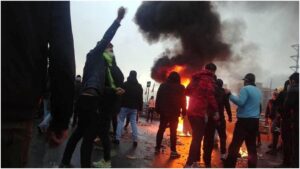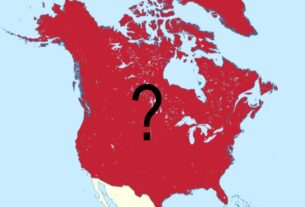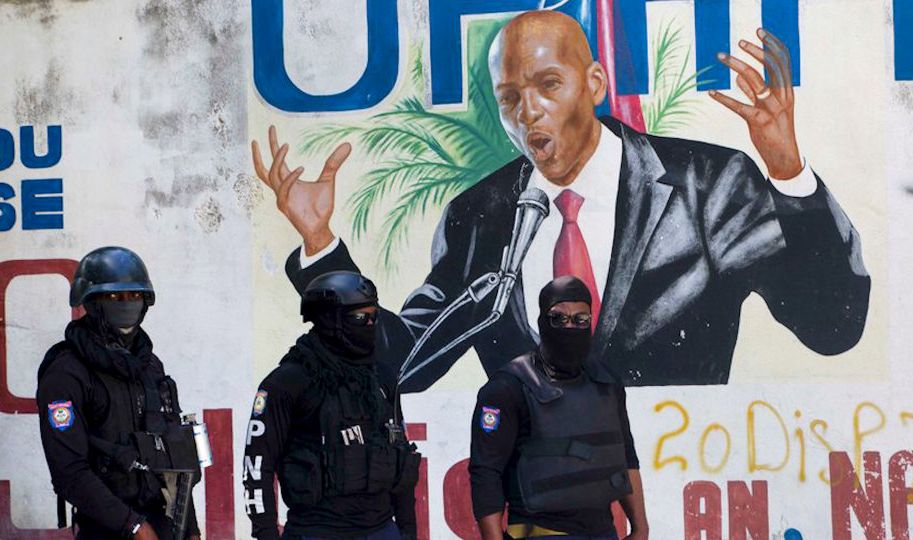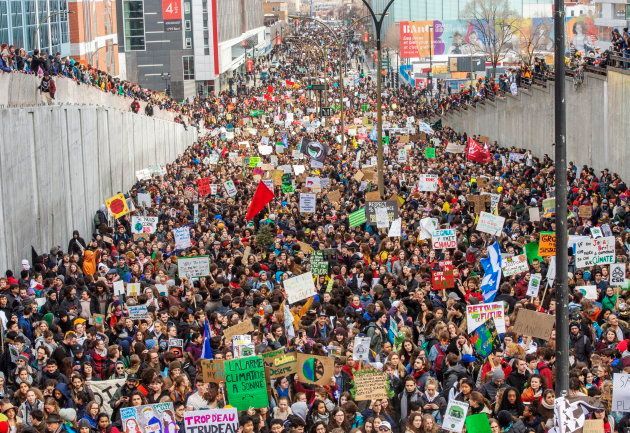Sarah Mo is a member of Sozialistische LinksPartei (CWI in Austria).
 After the Iranian regime announced an increase in petrol prices of between 50 and 300% and the simultaneous rationing of fuel at midnight on 15 November, masses of people came out onto the streets spontaneously in several cities. Since then, the protests have escalated dramatically.
The police and the paramilitary arm of the Revolutionary Guards (Basiji) reacted quickly, opening fire on the protests as soon as they broke out. The demonstrators blocked roads and highways, set fire to banks and petrol stations, as well as religious schools and institutions. As a result of the attacks by the police and the security forces, police stations were stormed by the masses. It is estimated that more than 1,000 demonstrators have been arrested and that at least 50 people killed. Despite this, the heroic struggle of the Iranian working class continues as the protests increasingly spread around the country.
Though during the second day, the regime shut down the Internet to block communication and coordination by demonstrators, also making it difficult to obtain reliable information, the protests have already spread to more than 100 cities, not only to large centres such as Tehran, Mashad, Isfahan and Shiraz, but also to many rural areas.
It is also significant that there are large numbers of the oppressed minorities participating, both in the Kurdish regions, but also in Lorestan, Azerbaijan and Khuzestan. These protests no longer distinguish between the large cities and provinces, but are spreading in all directions.
Petrol prices have a big effect on living standards in Iran. People realize that this increase will lead to massive price rises for many other products too. Already inflation is at 40%. The government says the move would raise money to help the Iranian people, “particularly those going through economic hardships” and that about 70% of the population would receive special “monthly bonuses” to offset the rise. But these promises do not fool anyone – it has been those Iranians already on low and middle-income wages who have suffered from the currency crisis and collapse of the economy by nearly 10% since the imposition of new US sanctions last year.
On Sunday, not only schools and universities closed in several cities, but Tehran’s bazaar, a historic hub of revolutionary uprisings also came out on strike. Even before these latest protests, workers at the Haft-Tapeh sugar factory, where great struggles have taken place in recent years against privatization and for the payment of outstanding salaries, had been on strike since 4 November. Steel workers in Ahwas, who also have a reputation for organizing radical labour struggles in recent years, are also involved in action. Individual town halls have been stormed and, although the reports are unconfirmed, there is sporadic talk on social media that parts of the small town of Fardis and other surrounding towns in the province of Alborz near to Tehran are occupied and controlled by the demonstrators.
These events are exacerbating the deep political and economic crisis, in part due to the effects of US sanctions combined with the recent outbreak of mass protests in surrounding states such as Iraq, Lebanon and Egypt, which is increasingly putting the regime under pressure.
After the last wave of protests in 2017/18 caused by the deterioration of the economy and price increases and which became a political uprising against the regime, it became clear that no peace would be restored. After that wave, the regime decided to turn to more repression to prevent future opposition. General Soleimani, Major General of the Revolutionary Guards, just last week in Iraq boasted that “we in Iran know how to deal with protests“. But this could not prevent this latest, inevitable, wave of resistance against the Iranian regime given the deep crisis in the country. Even the brutal repressive actions of the state, trembling with fear, just deepened the anger of the people, directed mainly against the Mullahs and President Ruhani.
A significant part of the anger however is also directed against US imperialism. In part this is because people understand that US sanctions are making the economic crisis worse. But playing on this, the Iranian regime is itself trying to blame the US for the crisis. Describing protesters as “thugs’ President Khamenei has blamed “counter-revolutionaries and foreign enemies of Iran”, remarks that were repeated later by the Foreign ministry which blamed the US for supporting a “group of rioters”.
It was only a matter of time before the mass uprisings in the region would spread to Iran. Iran plays a central role as a regional power, also in the development of revolutionary uprisings. A mass movement in Iran against the regime would be a battle in the belly of the beast. The instability of the mullah regime and the anger and fighting spirit of the Iranian working class and youth that is now erupting again can become a key lever for the development of mass uprisings in the region.
There have already been initial solidarity messages from Iraqi demonstrators to the protesters in Iran. A message from Al Tahrir Square says: “It is crucial for us that you should be aware of the fact that we Iraqi People only have a genuine love for you. Our problem is with the Iranian sectarian regime, which backs all the corrupt politicians, criminals, and murderers in our current government. Our ambition and only purpose is to get rid of our corrupted rulers, we are also looking forward to strong and stable relations with our Iranian neighbours who deserve a just and civilised government. Long Live the people”
It is immensely important to intensify this kind of international solidarity of all the oppressed in the region in order to overcome national, religious and ethnic divisions. What would have been necessary in 2009 and in 2017/18, namely to bring the struggle from the street into mass strikes – in a general strike, to take over factories and cities and thus bring down the regime, is now more necessary than ever.
In the course of this, there must be no trust in US imperialism – which is now once again hypocritically talking about solidarity, but has no interest in the real liberation of the Iranian people. A US-led “regime change”, as demonstrated in Iraq, under capitalist conditions and influenced by US imperialism won’t bring peace, economic stability and political freedom to Iran.
Nor does a return to monarchist ideas offer any way forward. Followers of the old Shah monarchy now see an opportunity to lean on the anger of the masses against the mullahs. These tendencies, as well as nationalism, can be pushed back by building on the strong traditions of working class struggle in Iran, to pursue an independent policy using its own strength to gain economic and political control over the country. In doing so, it will fight to take over the natural resources of the country, use them as part of a democratically planned economy to ensure the living standards of all working people and the poor, it will guarantee the rights of national minorities and establish a democratic socialist society which will act as a beacon for revolutionary movements throughout the region.
It is, of course, difficult to assess how the situation will develop in the days and weeks to come, how far the repression will go and whether there will be increasing coordination and centralization of the protests. But at the moment there is every reason to believe that the situation won’t calm down and that a new phase of revolutionary mass uprisings may be imminent.
After the Iranian regime announced an increase in petrol prices of between 50 and 300% and the simultaneous rationing of fuel at midnight on 15 November, masses of people came out onto the streets spontaneously in several cities. Since then, the protests have escalated dramatically.
The police and the paramilitary arm of the Revolutionary Guards (Basiji) reacted quickly, opening fire on the protests as soon as they broke out. The demonstrators blocked roads and highways, set fire to banks and petrol stations, as well as religious schools and institutions. As a result of the attacks by the police and the security forces, police stations were stormed by the masses. It is estimated that more than 1,000 demonstrators have been arrested and that at least 50 people killed. Despite this, the heroic struggle of the Iranian working class continues as the protests increasingly spread around the country.
Though during the second day, the regime shut down the Internet to block communication and coordination by demonstrators, also making it difficult to obtain reliable information, the protests have already spread to more than 100 cities, not only to large centres such as Tehran, Mashad, Isfahan and Shiraz, but also to many rural areas.
It is also significant that there are large numbers of the oppressed minorities participating, both in the Kurdish regions, but also in Lorestan, Azerbaijan and Khuzestan. These protests no longer distinguish between the large cities and provinces, but are spreading in all directions.
Petrol prices have a big effect on living standards in Iran. People realize that this increase will lead to massive price rises for many other products too. Already inflation is at 40%. The government says the move would raise money to help the Iranian people, “particularly those going through economic hardships” and that about 70% of the population would receive special “monthly bonuses” to offset the rise. But these promises do not fool anyone – it has been those Iranians already on low and middle-income wages who have suffered from the currency crisis and collapse of the economy by nearly 10% since the imposition of new US sanctions last year.
On Sunday, not only schools and universities closed in several cities, but Tehran’s bazaar, a historic hub of revolutionary uprisings also came out on strike. Even before these latest protests, workers at the Haft-Tapeh sugar factory, where great struggles have taken place in recent years against privatization and for the payment of outstanding salaries, had been on strike since 4 November. Steel workers in Ahwas, who also have a reputation for organizing radical labour struggles in recent years, are also involved in action. Individual town halls have been stormed and, although the reports are unconfirmed, there is sporadic talk on social media that parts of the small town of Fardis and other surrounding towns in the province of Alborz near to Tehran are occupied and controlled by the demonstrators.
These events are exacerbating the deep political and economic crisis, in part due to the effects of US sanctions combined with the recent outbreak of mass protests in surrounding states such as Iraq, Lebanon and Egypt, which is increasingly putting the regime under pressure.
After the last wave of protests in 2017/18 caused by the deterioration of the economy and price increases and which became a political uprising against the regime, it became clear that no peace would be restored. After that wave, the regime decided to turn to more repression to prevent future opposition. General Soleimani, Major General of the Revolutionary Guards, just last week in Iraq boasted that “we in Iran know how to deal with protests“. But this could not prevent this latest, inevitable, wave of resistance against the Iranian regime given the deep crisis in the country. Even the brutal repressive actions of the state, trembling with fear, just deepened the anger of the people, directed mainly against the Mullahs and President Ruhani.
A significant part of the anger however is also directed against US imperialism. In part this is because people understand that US sanctions are making the economic crisis worse. But playing on this, the Iranian regime is itself trying to blame the US for the crisis. Describing protesters as “thugs’ President Khamenei has blamed “counter-revolutionaries and foreign enemies of Iran”, remarks that were repeated later by the Foreign ministry which blamed the US for supporting a “group of rioters”.
It was only a matter of time before the mass uprisings in the region would spread to Iran. Iran plays a central role as a regional power, also in the development of revolutionary uprisings. A mass movement in Iran against the regime would be a battle in the belly of the beast. The instability of the mullah regime and the anger and fighting spirit of the Iranian working class and youth that is now erupting again can become a key lever for the development of mass uprisings in the region.
There have already been initial solidarity messages from Iraqi demonstrators to the protesters in Iran. A message from Al Tahrir Square says: “It is crucial for us that you should be aware of the fact that we Iraqi People only have a genuine love for you. Our problem is with the Iranian sectarian regime, which backs all the corrupt politicians, criminals, and murderers in our current government. Our ambition and only purpose is to get rid of our corrupted rulers, we are also looking forward to strong and stable relations with our Iranian neighbours who deserve a just and civilised government. Long Live the people”
It is immensely important to intensify this kind of international solidarity of all the oppressed in the region in order to overcome national, religious and ethnic divisions. What would have been necessary in 2009 and in 2017/18, namely to bring the struggle from the street into mass strikes – in a general strike, to take over factories and cities and thus bring down the regime, is now more necessary than ever.
In the course of this, there must be no trust in US imperialism – which is now once again hypocritically talking about solidarity, but has no interest in the real liberation of the Iranian people. A US-led “regime change”, as demonstrated in Iraq, under capitalist conditions and influenced by US imperialism won’t bring peace, economic stability and political freedom to Iran.
Nor does a return to monarchist ideas offer any way forward. Followers of the old Shah monarchy now see an opportunity to lean on the anger of the masses against the mullahs. These tendencies, as well as nationalism, can be pushed back by building on the strong traditions of working class struggle in Iran, to pursue an independent policy using its own strength to gain economic and political control over the country. In doing so, it will fight to take over the natural resources of the country, use them as part of a democratically planned economy to ensure the living standards of all working people and the poor, it will guarantee the rights of national minorities and establish a democratic socialist society which will act as a beacon for revolutionary movements throughout the region.
It is, of course, difficult to assess how the situation will develop in the days and weeks to come, how far the repression will go and whether there will be increasing coordination and centralization of the protests. But at the moment there is every reason to believe that the situation won’t calm down and that a new phase of revolutionary mass uprisings may be imminent.




